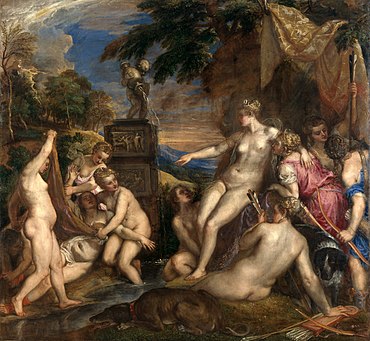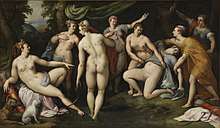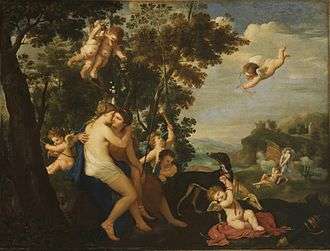Callisto (mythology)
In Greek mythology, Callisto or Kallisto (/kəˈlɪstoʊ/; Ancient Greek: Καλλιστώ [kallistɔ̌ː]) was a nymph, or the daughter of King Lycaon; the myth varies in such details. She was one of the followers of Artemis, or Diana for the Romans, who attracted Zeus (Jupiter). According to some writers, Zeus transformed himself into the figure of Artemis to lure Callisto and rape her. She became pregnant and when this was eventually discovered, she was expelled from Artemis's group, after which a furious Hera (Juno), the wife of Zeus (Jupiter), transformed her into a bear. Later, just as she was about to be killed by her son when he was hunting, she was set among the stars as Ursa Major ("the Great Bear"). She was the bear-mother of the Arcadians, through her son Arcas by Zeus.

The fourth Galilean moon of Jupiter and a main belt asteroid are named after Callisto.
Genealogy
| Name | Relation |
|---|---|
| Lycaon | Father |
| Arcas | Son/grand-uncle (Pelasgus's brother) |
| 50 sons of Lycaon | Brothers |
| Dia | Sister |
| Psophis | Sister |
| Pelasgus | Grandfather (Lycaon's father) |
| Meliboea | Grandmother (Lycaon's mother) |
| Zeus | Great-grandfather (Pelasgus's father) |
| Niobe | Great-grandmother (Pelasgus's mother) |
| Oceanus | Great-grandfather (Meliboea's father) |
| Tethys | Great-grandmother (Meliboea's mother) |
| Apheidas | Grandson (Arcas's son) |
| Elatus | Grandson (Arcas's son) |
| Azan | Grandson (Arcas's son) |
| Hyperippe | Granddaughter (Arcas's daughter) |
| Triphylus | Grandson (Arcas's son) |
| Diomeneia | Granddaughter (Arcas's daughter) |
| Erymanthus | Grandson (Arcas's son) |
Myth
As a follower of Artemis, Callisto, who Hesiod said[1] was the daughter of Lycaon, king of Arcadia,[2] took a vow to remain a virgin, as did all the nymphs of Artemis.
According to Hesiod,[3] she was seduced by Zeus, and of the consequences that followed:
[Callisto] chose to occupy herself with wild-beasts in the mountains together with Artemis, and, when she was seduced by Zeus, continued some time undetected by the goddess, but afterwards, when she was already with child, was seen by her bathing and so discovered. Upon this, the goddess was enraged and changed her into a beast. Thus she became a bear and gave birth to a son called Arkas.
According to the mythographer Apollodorus,[4] Zeus disguised himself as Artemis or Apollo, in order to lure Callisto into his embrace.
According to Ovid,[5] it was Jupiter who took the form of Diana so that he might evade his wife Juno's detection, forcing himself upon Callisto while she was separated from Diana and the other nymphs.[6] Callisto's subsequent pregnancy was discovered several months later while she was bathing with Diana and her fellow nymphs. Diana became enraged when she saw that Callisto was pregnant and expelled her from the group. Callisto later gave birth to Arcas. Juno then took the opportunity to avenge her wounded pride and transformed the nymph into a bear. Sixteen years later Callisto, still a bear, encountered her son Arcas hunting in the forest. Just as Arcas was about to kill his own mother with his javelin, Jupiter averted the tragedy by placing mother and son amongst the stars as Ursa Major and Minor, respectively. Juno, enraged that her attempt at revenge had been frustrated, appealed to Tethys that the two might never meet her waters, thus providing a poetic explanation for their circumpolar positions in ancient times.

Either Artemis "slew Kallisto with a shot of her silver bow,"[7] perhaps urged by the wrath of Juno (Hera)[8] or later Arcas, the eponym of Arcadia, nearly killed his bear-mother, when she had wandered into the forbidden precinct of Zeus. In every case, Zeus placed them both in the sky as the constellations Ursa Major, called Arktos (αρκτος), the "Bear", by Greeks, and Ursa Minor.
Origin of the myth

The name Kalliste (Καλλίστη), "most beautiful", may be recognized as an epithet of the goddess herself, though none of the inscriptions at Athens that record priests of Artemis Kalliste (Ἄρτεμις Καλλίστη), date before the third century BCE.[9] Artemis Kalliste was worshiped in Athens in a shrine which lay outside the Dipylon gate, by the side of the road to the Academy.[10] W. S. Ferguson suggested[11] that Artemis Soteira and Artemis Kalliste were joined in a common cult administered by a single priest. The bearlike character of Artemis herself was a feature of the Brauronia.
The myth in Catasterismi may be derived from the fact that a set of constellations appear close together in the sky, in and near the Zodiac sign of Libra, namely Ursa Minor, Ursa Major, Boötes, and Virgo. The constellation Boötes, was explicitly identified in the Hesiodic Astronomia (Ἀστρονομία)[12] as Arcas, the "Bear-warden" (Arktophylax; Ἀρκτοφύλαξ):[13]
He is Arkas the son of Kallisto and Zeus, and he lived in the country about Lykaion. After Zeus had seduced Kallisto, Lykaon, pretending not to know of the matter, entertained Zeus, as Hesiod says, and set before him on the table the babe [Arkas] which he had cut up.[14]
The stars of Ursa Major were all circumpolar in Athens of 400 BCE, and all but the stars in the Great Bear's left foot were circumpolar in Ovid's Rome, in the first century CE. Now, however, due to the precession of the equinoxes, the feet of the Great Bear constellation do sink below the horizon from Rome and especially from Athens; however, Ursa Minor (Arcas) does remain completely above the horizon, even from latitudes as far south as Honolulu and Hong Kong.
According to Julien d'Huy, who used phylogenetic and statistical tools, the story could be a recent transformation of a Palaeolithic myth.[15]
In art

Callisto's story was sometimes depicted in classical art, where the moment of transformation into a bear was the most popular.[16] From the Renaissance on a series of major history paintings as well as many smaller cabinet paintings and book illustrations, usually called "Diana and Callisto", depicted the traumatic moment of discovery of the pregnancy, as the goddess and her nymphs bathed in a pool, following Ovid's account. The subject's attraction was undoubtedly mainly the opportunity it offered for a group of several females to be shown largely nude.[17]
.jpg)
Titian's Diana and Callisto (1556-1559), was the greatest (though not the first) of these, quickly disseminated by a print by Cornelius Cort.[18] Here, as in most subsequent depictions, Diana points angrily, as Callisto is held by two nymphs, who may be pulling off what little clothing remains on her. Other versions include one by Rubens, and Diana Bathing with her Nymphs with Actaeon and Callisto by Rembrandt, which unusually combines the moment with the arrival of Actaeon.[19] The basic composition is rather unusually consistent. Carlo Ridolfi said there was a version by Giorgione, who died in 1510, though his many attributions to Giorgione of paintings that are now lost are treated with suspicion by scholars.[20] Other, less dramatic, treatments before Titian established his composition are by Palma Vecchio and Dosso Dossi.


Although Ovid places the discovery in the ninth month of Callisto's pregnancy, in paintings she is generally shown with a rather modest bump for late pregnancy. With the Visitation in religious art, this was the leading recurring subject in history painting that required showing pregnancy in art, which Early Modern painters still approached with some caution. In any case, the narrative required that the rest of the group had not previously noticed the pregnancy.
Callisto being seduced by Zeus/Jupiter in disguise was also a popular subject, usually called "Jupiter and Callisto"; it was the clearest common subject with lesbian lovers from classical mythology. The two lovers are usually shown happily embracing in a bower. The violent rape described by Ovid as following Callisto's realization of what is going on is rarely shown. In versions before about 1700 Callisto may show some doubt about what is going on, as in the versions by Rubens. It was especially popular in the 18th century, when depictions were increasingly erotic; François Boucher painted several versions.[21]
Aeschylus' tragedy Callisto is lost.
In popular culture
- In the television series Hercules: The Legendary Journeys and its spinoff Xena: Warrior Princess, Callisto is portrayed by Hudson Leick.
- In the video game Persona 2: Eternal Punishment, Callisto is the initial Persona of supporting character Ulala Serizawa.
- In the video game God of War: Ghost of Sparta, Callisto is portrayed as the mother of protagonist Kratos and undergoes transformation into a monstrous beast that the player must defeat.[22]
- In the video game The Secret World, Callisto is the nickname of a quest-giving non-player character and the myth related to a puzzle/investigation quest.[23]
- In music, the song "Like Callisto to a Star in Heaven" by American heavy metal band Trivium dramatically retells the myth of Callisto's rape, pregnancy, and exile.
Notes
- In his lost Astronomy, quoted in Catasterismi.
- Other writers gave her a mortal genealogy as the daughter of one or the other of Lycaon's sons: Pseudo-Apollodorus, Bibliotheke.
- In his lost Astronomy, quoted in Catasterismi.
- Bibliotheca, 3.8.2
- Ovid. Metamorphoses. Book II, Lines 405–531; Ovid narrates the myth also in Fasti, book II.
- The transformation of Zeus, with its lesbian overtones, was rendered as comedy in a lost work by the Attic Amphis (Theoi Project – Kallisto).
- Homerica, The Contest of Homer and Hesiod, 316 ff (trans. Hugh G. Evelyn-White).
- This was the version current in Greece when Pausanias visited in the second century CE (Pausanias, VIII.35.8).
- Daniel J. Geagan. "The Athenian Constitution After Sulla" (Hesperia Supplements 12 1967:72, 95).
- Klio: Beiträge Zur Alten Geschichte (Deutsche Akademie der Wissenschaften Zu Berlin Institut für Griechisch-Römische Altertumskunde) 1907.
- In Klio 7 (1907:213f).
- Hesiod, Astronomia, fragment 3, preserved as a quote in a commentary on Aratus.
- Thus Hesiod is quoted, though Boötes, Βοώτης, from his very name, is a cow (βοως) herdsman.
- The episode is a doublet of the serving up of Pelops.
- d'Huy Julien, Un ours dans les étoiles: recherche phylogénétique Sur un mythe préhistorique. Préhistoire du sud-ouest, 20 (1), 2012: 91-106 ; A Cosmic Hunt in the Berber sky : a phylogenetic reconstruction of Palaeolithic mythology. Les Cahiers de l'AARS, 15, 2013: 93-106 .
- Gods
- There is a good but by no means complete, selection at Warburg Institute Iconographic Database, Myths → Callisto's pregnancy discovered by Diana; more on Wikimedia Commons
- Brigstocke, 184
- Hall, Gods
- Jane Martineau (ed), The Genius of Venice, 1500–1600, 207, 1983, Royal Academy of Arts, London
- Hall, Gods
- "Walkthrough - Temple of Poseidon - God of War: Ghost of Sparta Wiki Guide - IGN". IGN. Retrieved 2018-01-13.
- "The Secret World: The Red Thread Guide / Solution : Unfair.co". unfair.co. Retrieved 2018-01-31.
References
- Brigstocke, Hugh; Italian and Spanish Paintings in the National Gallery of Scotland, 2nd Edn, 1993, National Galleries of Scotland, ISBN 0903598221
- "Gods": Aghion I., Barbillon C., Lissarrague, F., "Callisto", in Gods and Heroes of Classical Antiquity, Flammarion Iconographic Guides, pp. 77-78, 1996, ISBN 2080135805
- Hall, James, "Diana: 5", in Hall's Dictionary of Subjects and Symbols in Art, pp. 102-103, 1996 (2nd edn.), John Murray, ISBN 0719541476
Further reading
- Pseudo-Apollodorus. Bibliotheke III.8.2.
- Hyginus, attrib., Poeticon astronomicon, II.1: the Great Bear.
External links
| Wikimedia Commons has media related to Callisto (mythology). |
- Hesiod, Astronomy, quoted by the Pseudo-Eratosthenes, Catasterismi: e-text (English)
- Theoi Project – Kallisto
- Richard Wilson's 'Landscape with Diana and Callisto' at the Lady Lever Art Gallery
- Warburg Institute Iconographic Database (ca 175 images of Callisto)